Lal R., Shukla M.K. Principles of Soil Physics
Подождите немного. Документ загружается.


TABLE 18.8 Effect of Drainage on Soil Physical
Property
Undrained Drained
Property 0–15 cm 15–30 cm 0–15 cm 15–30 cm
ρ
b
(g cm
−3)
1.29 1.36 1.22 1.32
w (%) 30.4 29.2 30.1 29.6
K
s
(cm h
−1
) 0.1 0.08 2 0.8
P
a
9 7 15 10
UCS (kg cm
−2
) 2.5 3.0 1.8 2.2
a
Where ρ
b
is bulk density; w is gravimetric moisture content at 1 bar (%); K
s
is saturated hydraulic
conductivity; P
a
is air filled porosity at 0.5 bar; UCS is unconfined compressive strength.
Source: Modified from Hundal et al., 1976.
TABLE 18.9 Effect of Water Table Depth on SOC
(Mgm
−3
)
Depth (cm)
Treatment Sample number 8 to 16 16 to 24
7 2.37 2.3 Drained
4 2.53 2.37
7 2.58 2.34 Undrained
4 2.62 2.59
Source: Modified from Sullivan et al., 1997.
, which depending upon the prevalent climate of area, can increase the intensity of
hot/cold, and freeze/thaw cycles, thereby causing a change in soil aggregation and overall
structural properties.
18.6 SOIL RESPIRATION
Soil respiration is the amount of oxygen consumption or CO2 evolution in the soil. The
rate of soil respiration varies with space and time and depends upon soil water content,
soil type, plant cover, and agriculture measures and amendments. Soil respiration can be
measured both under field and laboratory conditions using various types of respirators or
respirometers. The respiratory coefficient, which provides useful information on soil
aeration, is the ratio of the volume of CO
2
produced to the volume of O
2
consumed. For a
well-aerated soil, the respiratory quotient is equal to one. The aerobic or anaerobic
conditions of soil can be checked as follows (Monteith et al., 1964):
Principles of soil physics 524
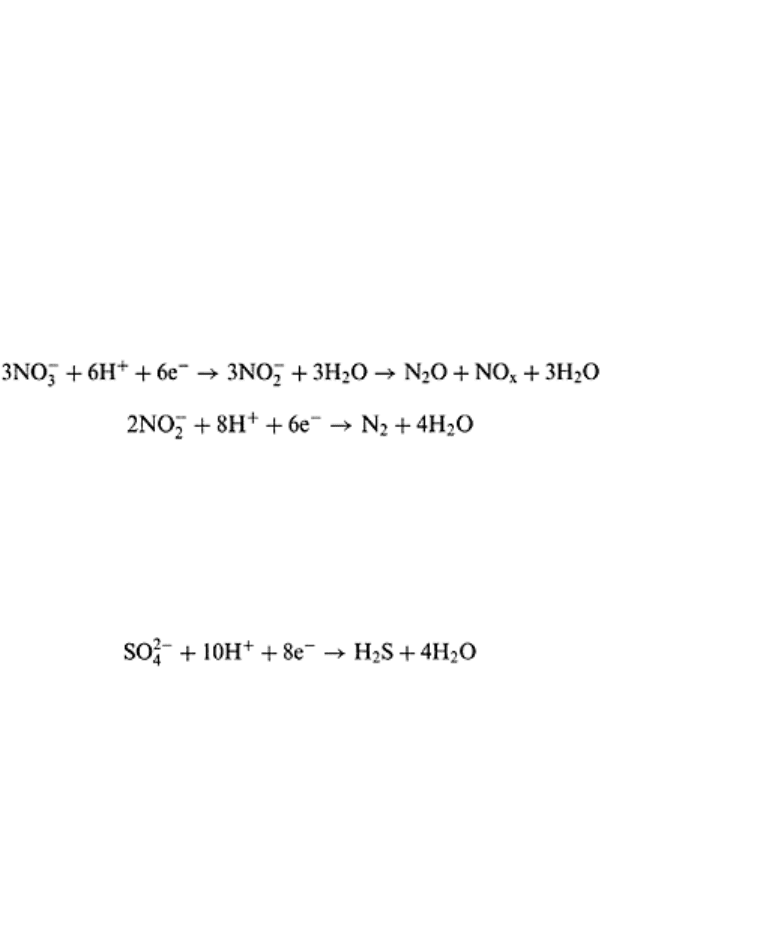
R=R
0
Q
T/10
(18.2)
where R is the flux at T°C and R
0
at 0°C and Q is equal to 3 (Monteith et al., 1964). The
concentration of O
2
consumed and CO
2
released in a cropped and bare soil is also
presented in Table 18.6 as an example.
18.7 OXIDATION REDUCTION PROCESS IN SOIL
The chemical and biochemical reactions, which occur in soil under anaerobic condition,
are dentrification and reduction of manganese (Mn), iron (Fe), and sulfate (SO
4
). Nitrate
(NO
3
) is reduced to nitrite (NO
2
), then to nitrous oxide (N
2
O), and eventually to
elemental nitrogen (N
2
). The process of decrease in nitrate content with time in a flooded
or saturated soil is known as denitrification. The rate of denitrification depends on soil
saturation, pH, and temperature. Denitrification is an anaerobic process and an indicator
of the absence of O
2
in at least a part of soil volume. The end products in a denitrification
process are gaseous (N
2
O, NO, and N
2
) (Ponnamperuma, 1972).
(18.3)
(18.4)
Manganese reduces from a manganic (Mn
+4
) to magnous (Mn
+2
) state, iron from a ferric
(Fe
+3
) to ferrous (Fe
+2
) state, and sulfate (SO
4
) to hydrogen sulfide (H
2
S).
Mn
4+
+2e−→Mn
2+
(18.5)
Fe
3+
+e−→Fe
2+
(18.6)
(18.7)
Some of the toxic substances produced during anaerobic conditions are (H
2
S), ethylene
(C
2
H
4
), and acetic (C
2
H
4
O
2
), butyric (C
4
H
8
O
2
) and phenolic (C
6
H
5
OH) acids.
The process of production of CH
4
is known as methanogenesis. Methanogenic bacteria
generate CH
4
biologically, largely from acetate (CH
3
COOH) dissimilation and CO
2
reduction. The methanogens are capable of obtaining energy for growth by converting
CO
2
and molecular hydrogen into CH
4
and H
2
O.
CO
2
+4H
2
→CH
4
+2H
2
O
(18.8)
Some methanogenic bacteria are also capable of transforming acetate into CH
4
and CO
2
.
CH
3
COOH→CO
2
+CH
4
+35.6 kJmol
−1
(18.9)
Soil air and aeration 525

The H
2
is a product of anaerobic degradation of organic matter. The H
2
with acetate is
one of the most important intermediates in the methanogenic degradation of organic
matter and serves as a substrate for methanoge-nic process (Conrad, 1999).
Methanogenesis is a major pathway for organic matter decay in sediments. The factors
controlling methanogenesis are temperature, concentration of other electron acceptors,
water table position, substrate (e.g., H
2
) availability, and oxygen supply (Boon and
Mitchell, 1995; Grunfeld and Brix, 1999). As temperature increases, water table in the
root zone rises and other electron acceptors (e.g., NO
3
, Fe
3
, SO
4
) reduce, methanogenesis
increases (Kluber and Conrad, 1998). Methanogenesis occurs in flooded soils, as well as
in soils at low water content incubated under anaerobic condition (Boon and Mitchell,
1995). Rice fields are estimated to contribute 100±50Tg yr
−1
of the greenhouse gas CH
4
(Kluber and Conrad, 1998). Production of CH
4
occurs during fermentation process by
anaerobic bacteria. In flooded soils, CH
4
appears from several days to weeks after
flooding. The organic matter amendment stimulates CH
4
formation in alkaline soils,
whereas it is suppressed in acid soils (Glinski and Stepniewski, 1985).
C
6
H
12
O
6
→2CH
3
COOH+CO
2
+CH
4
+346.8 kJmol
−1
(18.10)
The electron transfer is the primary source of energy needed by microorganisms for
various processes. Glucose releases electron upon oxidation as follows
C
6
H
12
O
6
=2CH
3
COCOOH+4H
+
+4e
−
(18.11)
In anaerobic conditions O
2
, NO
3
, H
+
, and high valency iron and manganese accept
electrons and are reduced to H
2
O, N
2
, H
2
, lower valency Fe
+2
, and Mn
+2
, respectively.
0
2
+4H
+
+4e
−
→2H
2
O
(18.12)
2H
+
+2e
−
→H
2
(18.13)
This tendency of a substance to accept or donate electrons is measured in terms of the
oxidation-reduction potential, commonly known as the oxidation-reduction potential or
“redox potential.” It is defined as “the potential in volts required in an electric cell to
produce oxidation at the anode and reduction at the cathode.” The redox potential is a
relative term and is measured relative to a standard hydrogen electrode also known as
reference electrode whose potential is assumed to be zero. The potential has an inverse
relationship with the rate of reduction of substances. The redox potential of soil is closely
linked to the availability of O
2
, especially at low O
2
levels, and can identify the changes
in availability of O
2
. The redox potential can be represented as follows:
(18.14)
where E
h
is the potential difference between the reference electrode and inert platinum
(Pt) electrode, E
0
is the potential of reference electrode, R is the gas constant, T is
Principles of soil physics 526

absolute temperature, n is the number of electrons transferred in the reaction, F is
Faraday’s constant, “Ox” is activity of oxidized specie, and “Red” is the activity of
reduced specie. From Eq. (18.14), it is clear that the E
h
is proportional to the natural log
of reduced and oxidized products. In well-drained soils, a sufficient amount of O
2
is
available, therefore, they can be called oxidized systems. The typical E
h
values for
oxidized systems are > 400 mV. The O
2
disappears at about 300 mV, is removed
between 200 and 300 mV, and and are reduced sequentially with
decrease in Eh value (Poonamperuma, 1972; Scott, 2000).
18.8 FLOW OF AIR IN SOIL
The gaseous exchange between soil and atmosphere occurs by two processes: convection
and diffusion. The convective flow of air in soil occurs as a result of the total pressure
difference between the soil air and
TABLE 18.10 Increase in CO
2
Content for
Calcareous Silty Clay Loam (SCL) and Sandy
Loam (SL) Near Field Capacity Under Tensions for
Short Period of Time
Soil Duration minute Tension (kPa) CO
2
(%)
SCL 35 35 6.6
SCL 40 29 8.7
SCL 67 41 4.8
SL 18 39 17.4
SL 20 28 4.6
Source: Modified from Boynton and Reuther, 1938.
outer atmosphere. The pressure difference is caused as a result of O
2
consumption by
plant roots, CO
2
production in the soil (Table 18.10), change in the barometric pressure in
the atmosphere, soil temperature, moisture content, or water table depth of soil due to
evaporation, drainage, or water supply by rainfall or irrigation, etc. Various studies have
pointed out that convection of air in soil is predominant for shallow depths and in soils
with large pores (Rolston, 1986). The convective flow of air in the soil is similar to water
flow and is proportional to the pressure gradient across the flow domain. However, since
air is compressible, the density and viscosity are also the functions of pressure and
temperature. Unlike water flow, gravity is not important for airflow. Air is not attracted
to mineral particles and occupies the larger pores. Using Darcy’s law for water flow
[refer to Eq. (12.3)] the convective flux (q
a
) for laminar airflow is given as follows
(18.15)
Soil air and aeration 527
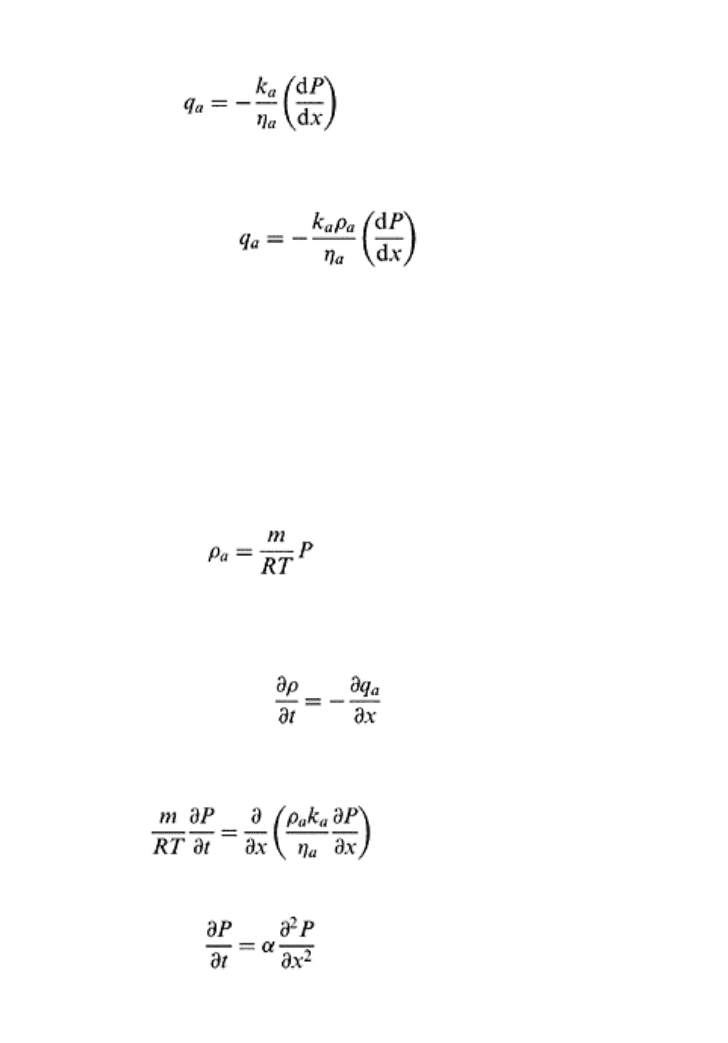
where is the three-dimensional gradient of soil air pressure. If the permeability of air-
filled pore space is k
a
, and viscosity of soil air is ηa, then one-dimensional convective
flow can be given as follows (Hillel, 1998)
(18.16)
If the density of soil air is ρ
a
, then air flux (q
a
) expressed as mass flow per unit area per
unit time is
If soil air is assumed to be an ideal gas at pressure, P, occupying a volume, V, then the
ideal gas equation for soil air can be written as
PV = nRT
(18.18)
where n is number of moles of gas, R is the universal gas constant per mole, and T is
absolute temperature. Substituting the density, ρ
a
=M/V, and M=nm, in Eq. (18.18) where
m is the molecular weight, and after rearranging, the following relationship for density is
obtained.
(18.19)
For a one-dimensional compressible fluid, the rate of change of pressure with respect to
time is equal to the rate of change of mass flux with respect to length of fluid mass and
can be expressed as
Substituting Eqs. (18.17) and (18.19) into Eq. (18.20) results in
(18.21)
For small pressure differences, ρ
a
k
a
/η
a
can be assumed a constant (Hillel, 1998).
(18.22)
where a = (RTρ
a
k
a
)/mη
a
. The above equation is an approximate equation for the transient-
state convective flow of air in soil. Convective flow rarely meets more than 10% of the
Principles of soil physics 528
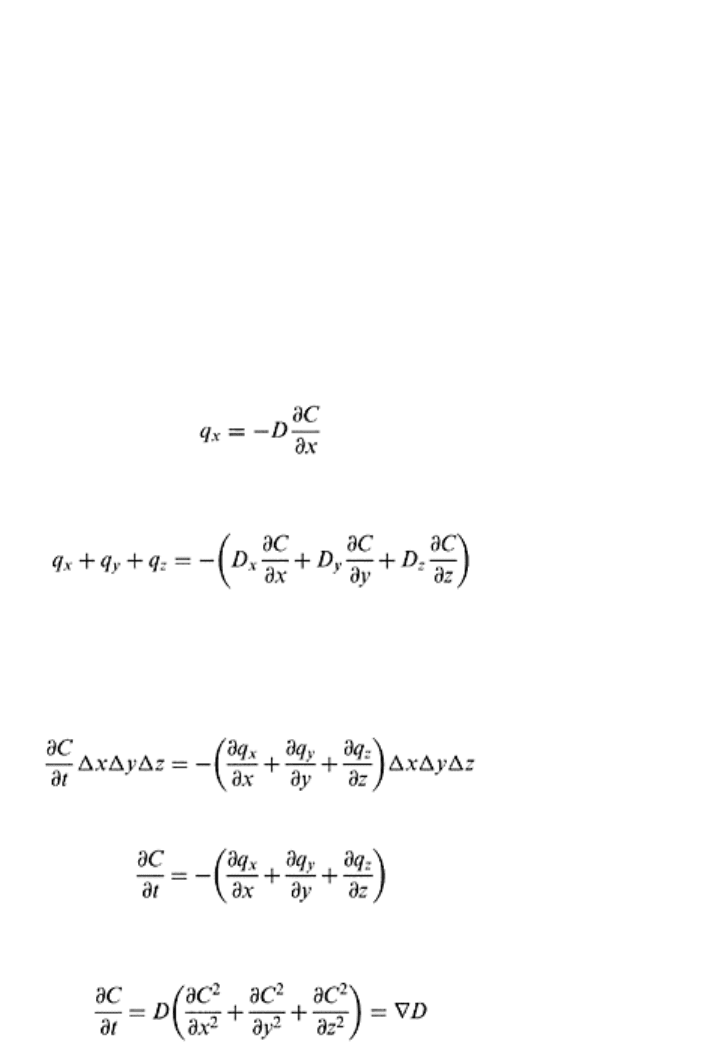
O
2
demand of plant roots (see Example). Thus, diffusion is the more important
mechanism of soil aeration (Russell, 1952).
18.9 FICK’S LAW AND GASEOUS DIFFUSION IN SOIL
The gaseous transport of O
2
and CO
2
in the soil occurs both in the gaseous and liquid
phases. The process of diffusion (random thermal molecular movement from high to low
concentration; also refer to Chapter 16) maintains the air exchange between soil and
surrounding atmosphere, whereas the supply of O
2
and removal of CO
2
from the plant
roots or live tissues takes place by diffusion through water films. According to Fick’s
law, the mass rate of transfer of a diffusing gas through a unit area of bulk soil is
proportional to the concentration gradient measured normal to the surface through which
diffusion is taking place. If D is the diffusion rate (cm
2
s
−1
), C is the concentration of
diffusing substances (g cm
−3
), q
x
is the rate of transfer of mass per unit area (gcm
−2
s
−1
),
and x is the distance of diffusion (cm), the diffusion of gases in both phases can be
represented by the following one-dimensional equation
(18.23)
The three-dimensional diffusion of gases according to Fick’s law is represented as
follows:
(18.24)
where q
x
, q
y
and q
z
are the rate of transfer of mass per unit area, and D
x
, D
y
, and D
z
are
gaseous diffusivity, in x, y, and z directions. The partial differential equation of diffusion
can be derived, similar to Laplace’s equation, by equating the difference between the
inflow and outflow of a diffusing substance in a volume element to the change in
concentration with time.
(18.25)
or
(18.26)
From Eqs. (18.24) and (18.26), assuming the diffusion coefficient is independent of
direction, the differential equation for three-dimensional gas flow is obtained as follows:
(18.27)
Soil air and aeration 529
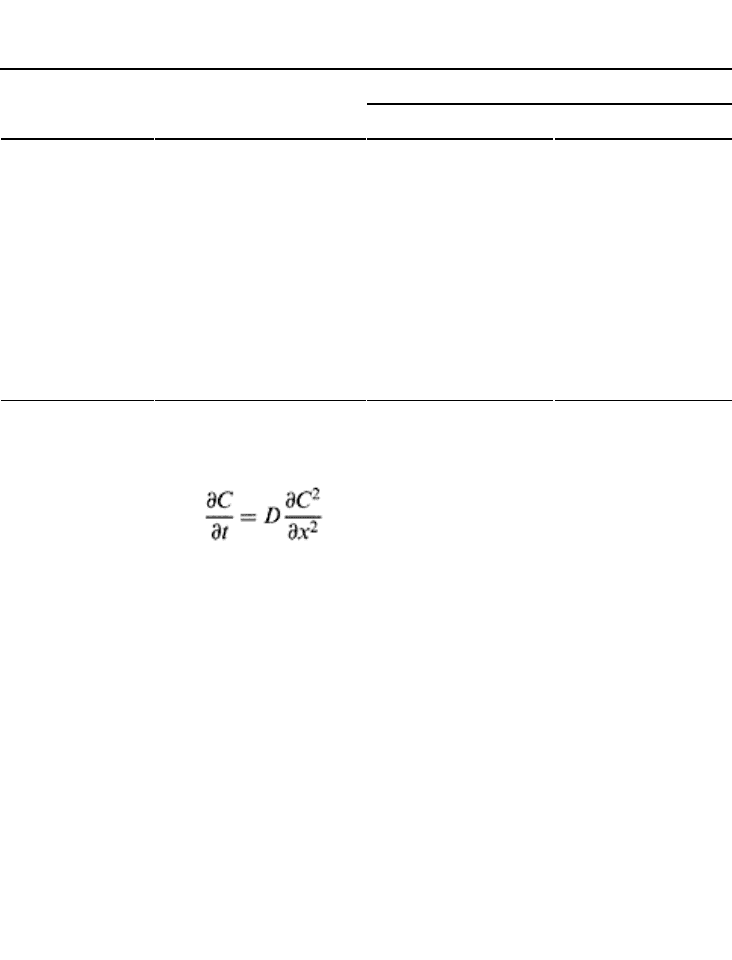
TABLE 18.11 Diffusion Coefficient of Some
Gases Under Standard Pressure and Temperature
Diffusion coefficient (m
2
s
−1
)
Gas Density (kgm
−3)
In air In water
O
2
1.429 1.78 ×10
−5
2.6×10
−9
CO
2
1.977 1.39×10
−5
1.91×10
−9
N
2
1.251 1.8×l0
−5
1.9×l0
−9
H
2
0.08 6.34×10
−5
5.85×10
−9
Water vapor 0.768 2.39×10
−5
NH
3
0.771 1.98×10
−5
2.0×10
−9
N
2
O 1.978 1.43×10
−5
C
2
H
4
1.261 1.37×10
−5
Source: Data from Weast et al., 1989.
The one-dimensional form of gaseous diffusion in a porous medium is given by
(18.28)
which is similar to Eq. (16.17) when mass flow (second term on the right hand side) is
zero. D varies inversely with the molecular weight of gas and is a direct function of
temperature and pressure of the gaseous medium. Under standard pressure and
temperature, the D in soil air is 10,000 times greater than in soil water (Table 18.11).
Under normal atmospheric pressure and 25°C, the D ranges from 0.05 and 0.28 cm
2
s
−1
;
the value depends on the volume of phase available for diffusion. The D is not affected
by the shape of solid surfaces or by the particle size or pore size distribution of soil solids
because mean free path of diffusing molecule is generally much smaller than the width of
the pores.
Considering the diffusive path in the air phase of soil, the diffusion coefficient in soil
D
s
is much smaller than in air D
a
. The ratio Ds/Da is known as relative diffusion
coefficient. The D
s
and D
a
are related by some function of air-filled porosity (f
a
), which
are presented in Table 18.12. The tortuosity coefficient of 0.66 (Table 18.12) (Penman,
1940) suggests that straight-line paths are only 66% of total average path of diffusion in
soil. Van Bavel (1952) suggested the value of coefficient to be 0.61 rather than 0.66. The
advantage of using the dimensionless coefficient or ratio is that the effects of state
variables such as pressure, temperature, and type of gas are cancelled.
Principles of soil physics 530
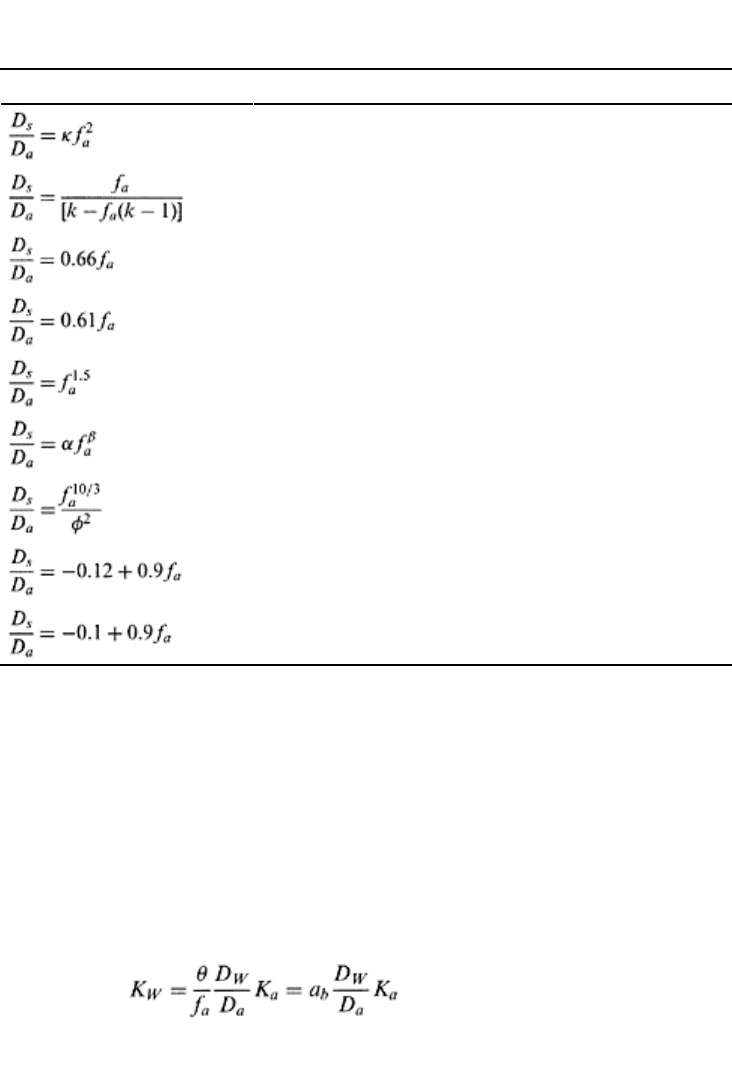
TABLE 18.12 Models of D
s
/D
a
as a Function of
Volumetric Air Content
Relationship Reference
(κ is a constant), Buckingham (1904)
Burger (1919)
Penman (1940)
Van Bavel (1952)
Marshall (1959)
Currie (1960)
Millington (1959), Millington and Quirk (1961)
Wesseling and Van Wijk (1957)
Wesseling (1962)
The O
2
and CO
2
can diffuse both in gaseous and aqueous systems, a diffusion constant K
a
can be defined, which separates the contribution from these two phases. The diffusion
constant in air (K
a
) is given as follows:
K
a
=f
a
D
a
(18.29)
And diffusion constant in water K
w
is
K
w
= θD
w
(18.30)
The ratio of Eqs. (18.29) and (18.30) after rearrangement yields
(18.31)
where a
b
is Bunsen’s solubility coefficient.
Soil air and aeration 531
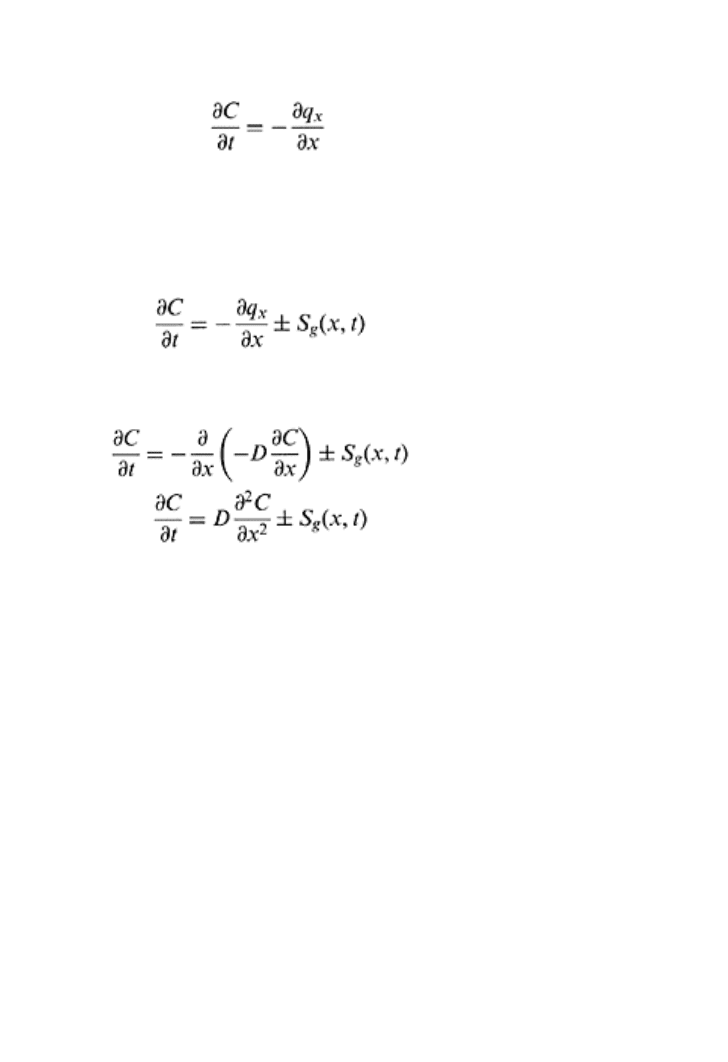
18.10 SOURCES AND SINKS OF GASES IN SOIL
The continuity equation states that the rate of change of concentration of a diffusing gas
equals the rate of change of flux with distance. Mathematically, it is expressed as follows:
(102)
Equation (18.32) implies that a diffusing substance follows the law of conservation of
matter. However, during the transport of CO
2
and O
2
through the soil system, the plant
roots or anaerobic activities along diffusional path absorb O
2
and release CO
2
.
Considering S
g
to be a source and sink term in time and space, Eq. (18.32) is modified as
follows (Hillel, 1998; Scott, 2000):
(18.33)
Substituting Eq. (18.23) into Eq. (18.33) and assuming D constant in diffusional path
yields
(18.34)
(18.35)
After a rainstorm or irrigation, the larger pores drain quickly and smaller pores or
intraaggregate micropores drain slowly. The gaseous diffusion also takes place rather
rapidly from interaggregate macropores. The plant roots are also confined to larger pores
between aggregates but do not penetrate them. Therefore, larger pores remain well
aerated whereas micropores remain anaerobic.
18.11 MEASUREMENT OF SOIL AERATION
Measurement of soil aeration involves assessing: (i) fractional pore space, (ii)
composition of soil air, and (iii) rate of diffusion of O
2
from atmosphere into the soil. The
aeration is measured by measuring the air-filled porosity at a standard value of soil
suction or soil water content. This is done by collecting a core sample from a soil at field
capacity (normally 24 to 48 h after a deep wetting or at soil water suction of about 50 cm
of water) and measuring air-filled space with an air pycnometer. Alternately, first
obtaining total porosity from bulk density (ρb) and particle density (ρs), and subtracting
the water content of core can calculate the air-filled porosity (fa). Measurement of the
relative concentration of O
2
, CO
2
, and other gases in the soil air provides important
information on the aeration and soil structure. Depletion of O
2
level content in soil air is a
good indicator of the restricted gas exchange in the soil matrix. This method, although
static, is better than the measurement of air volume alone. However, it requires extraction
Principles of soil physics 532
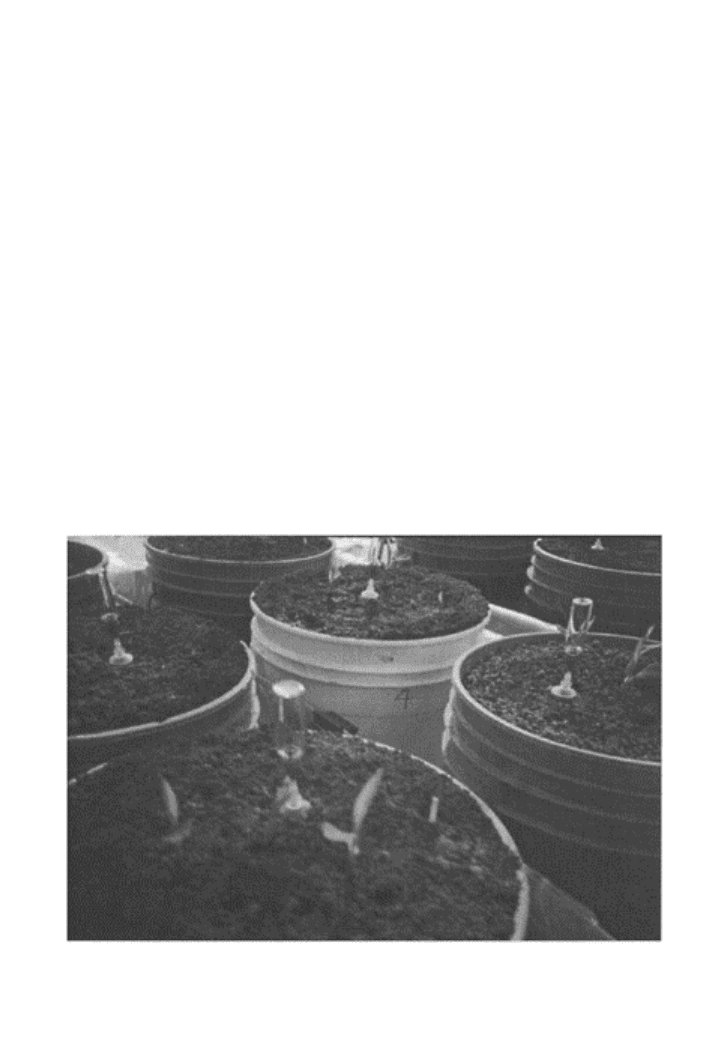
of a sample that is large enough to provide a measurement but at the same time small
enough to be representative. Another drawback of this method is soil disturbance and
contamination or mixing of air from the atmosphere. The repeated measurements of O
2
or
CO
2
concentrations in soil air without extracting a sample can also be obtained by the
electrode methods (McIntyre and Philip, 1964; Phene, 1986). The measurement of
depletion of O
2
or increase in CO
2
can be made both in situ or in a laboratory by gas
chromatography technique, which provides reliable measurements. The method allows
rapid and precise measurement of N
2
, O
2
, Ar, CO
2
, CH
4
, Ne, H
2
, CO, NO, C
2
H
4
, and
C
2
H
6
by employing a wide range of methods, detectors, and column packing (Blackmer
and Bremner, 1977). The in situ method for measuring O
2
and CO
2
are based on
detecting the thermal conductivity by paramagnetic oxygen analyzer and potable carbon
analyzer (van Bavel, 1965), respectively.
An early approach to measure aeration involved the determination of the fractional air
space or air filled porosity (f
a
) at a standardized value of soil wetness. This was measured
by either taking a core sample from the field two days after a deep wetting, or saturating
the core sample with water and then subjecting it to a suction of 50 cm. All the pores with
an effective diameter greater than 0.06 mm (r =0.147/50 cm) are drained of water. The air
space as a fraction of porosity now can be determined with an air pycnometer (Page,
1948; Vomocil, 1965). Alternatively, the air space can be determined by the difference of
porosity and volumetric wetness (f
a
=f
t
−θ). However, these two methods are not adequate
as considerable uncertainties exist in the measurement and aeration dynamics remains
almost untouched.
FIGURE 18.2 Soil air diffusion tube
installed in a greenhouse water table
management experiment. Similar
Soil air and aeration 533
